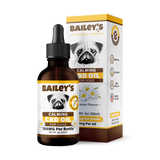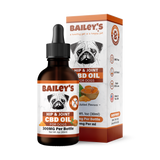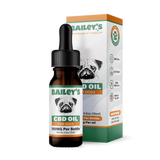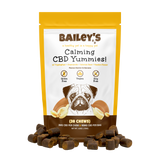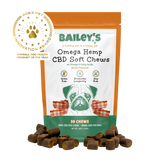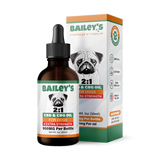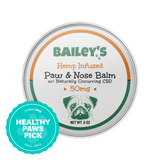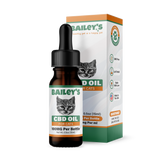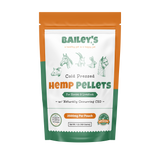Ham and Cats: Dietary Considerations

A cat's diet plays a crucial role in their overall health and well-being. As responsible pet owners, it is essential to understand the dietary needs of our feline companions. When it comes to ham, many cat owners wonder whether it is safe for their furry friends to consume.

In this article, we will explore the topic of ham and cats, covering important considerations such as feline dietary needs, the truth about cats and ham, safe feeding practices, addressing common myths, and consulting with a veterinarian. Read on to gain a deeper understanding of the topic, with the help and guidance of pets’ friends at Bailey’s CBD , and make informed decisions regarding your cat's diet.
Table of Contents
1. Understanding Feline Dietary Needs
Before discussing ham specifically, it is vital to establish a foundation of knowledge regarding the essential nutrients cats require. Cats are obligate carnivores, meaning they require a diet primarily consisting of meat. The nutrients crucial for their well-being include:
- Protein: Cats need high-quality animal-based proteins to support their muscular structure and overall growth.
- Taurine: This amino acid is essential for cats and plays a crucial role in maintaining their heart health and vision.
- Vitamins and Minerals: Cats require a balance of various vitamins and minerals, including vitamin A, vitamin E, calcium, and phosphorus, among others.
Ensuring that your cat's diet fulfills these nutritional requirements is essential for their long-term health.
Protein is a vital component of a cat's diet as it provides the necessary building blocks for their muscular structure and overall growth. Cats are natural hunters, and their bodies have evolved to process and utilize animal-based proteins efficiently. When cats consume protein, it is broken down into amino acids, which are then used to build and repair their muscles, organs, and other tissues. Without sufficient protein intake, cats may experience muscle wasting, weakness, and a compromised immune system.
Taurine is an amino acid that is particularly important for cats. Unlike humans and dogs, cats cannot produce sufficient amounts of taurine on their own and must obtain it from their diet. Taurine plays a crucial role in maintaining heart health and vision. It helps regulate the heart's rhythm and prevents the development of certain heart diseases. Additionally, taurine is essential for proper retinal function, ensuring that cats maintain good eyesight throughout their lives.
In addition to protein and taurine, cats require a balanced intake of various vitamins and minerals to support their overall health. Vitamin A is essential for maintaining healthy skin, coat, and vision. It also plays a vital role in supporting the immune system. Vitamin E is an antioxidant that helps protect cells from damage and supports healthy skin and coat. Calcium and phosphorus are crucial for maintaining strong bones and teeth. These are just a few examples of the many vitamins and minerals that cats need to thrive.
When choosing a cat food, it is important to read the labels and ensure that it provides the necessary nutrients for your cat's well-being. Look for high-quality cat foods that list animal-based proteins as the main ingredients. Avoid foods that contain excessive amounts of fillers, such as grains, as cats have limited ability to digest carbohydrates. Additionally, consult with your veterinarian to determine the specific dietary needs of your cat based on their age, weight, and any underlying health conditions.
2. The Truth About Cats and Ham
Ham is a meat product derived from pigs and often enjoyed by humans. However, it is important to recognize that what is suitable for humans may not necessarily be appropriate for our feline friends. When it comes to cats and ham, there are a few key points to consider:
While ham is a high-protein food that contains essential amino acids, it is typically cured, and seasoned, and may contain additives such as salt or preservatives. These factors can affect the nutritional content of ham and its suitability for cats. Additionally, ham tends to be high in fat, which can lead to obesity or digestive issues if consumed in large quantities.
2.1 Nutritional Content of Ham
Ham is a rich source of protein, which is essential for cats to maintain their overall health and well-being. Protein provides the necessary building blocks for muscle development, tissue repair, and the production of enzymes and hormones. However, it is crucial to ensure that cats receive a balanced diet that includes all the necessary nutrients they need to thrive.
When it comes to ham, while it does contain protein, it is important to note that the curing and seasoning process can alter its nutritional profile. The addition of salt and other additives can affect the overall sodium content, which may not be suitable for cats. High sodium intake can lead to dehydration and put additional strain on a cat's kidneys, potentially leading to health issues in the long run.
2.2 Potential Risks of Feeding Ham to Cats
Feeding ham to cats in small amounts occasionally may not pose significant risks. However, it is crucial to be aware of the potential dangers associated with including ham in their regular diet:
- High Sodium Content: Ham is often cured with salt and can be excessively salty. A high-sodium diet can lead to dehydration and put additional strain on a cat's kidneys. It is important to note that cats have different dietary needs compared to humans, and what may be a safe level of sodium for us can be harmful to them.
- Seasonings and Additives: The seasonings and additives present in ham, such as garlic or onion, can be toxic to cats. Cats lack certain enzymes in their digestive system that help break down these substances, making them more susceptible to their harmful effects. It is crucial to avoid feeding cats ham that contains any potentially toxic ingredients.
- Potential Allergic Reactions: Cats, like humans, can develop allergies to certain foods. Introducing ham to their diet increases the risk of allergic reactions. Symptoms of food allergies in cats can range from mild gastrointestinal upset to more severe reactions like skin rashes or difficulty breathing. It is always best to consult with a veterinarian before introducing any new food to your cat's diet.
Considering these potential risks, it is generally recommended to limit or avoid feeding ham to cats to ensure their optimal health. While it may be tempting to share our favorite foods with our furry companions, it is essential to prioritize their specific dietary needs and provide them with a balanced and nutritionally appropriate diet. There are plenty of other cat-friendly protein sources available that can meet their nutritional requirements without the potential risks associated with ham.
3. Safe Feeding Practices for Cats
When it comes to providing a well-balanced and safe diet for your cat, a few key practices should be followed:
- Choose High-Quality Cat Food: Select cat food that meets the nutritional standards set by the Association of American Feed Control Officials (AAFCO). Look for products that list meat, meat byproducts, or seafood as the first ingredients.
- Appropriate Portion Control: Feed your cat according to its age, size, and activity level. Overfeeding can lead to obesity, while underfeeding can cause nutritional deficiencies. It's best to consult with a veterinarian for personalized feeding recommendations.
- Maintain a Consistent Feeding Schedule: Cats thrive on routine. Feeding them at the same times each day can help regulate their digestive system and reduce the risk of obesity and diabetes.
- Fresh Water Availability: Always provide your cat with access to fresh, clean water. Hydration is essential for their overall health, especially for cats on a dry food diet.
- Limit Treats and Human Food: Treats should only make up a small percentage of your cat’s diet. Avoid feeding human food as it can contain ingredients harmful to cats, like onions, garlic, and chocolate.
- Monitor Food Intake and Health: Keep an eye on how much your cat eats and its general health. Changes in appetite or weight can be early signs of health issues.
- Transition to New Foods Gradually: When introducing new food, do it gradually over several days to avoid upsetting your cat’s stomach.
- Avoid Toxic Foods: Some foods that are safe for humans can be harmful to cats, including grapes, raisins, alcohol, caffeine, and xylitol.
As a responsible cat owner, it is important to prioritize the health and well-being of your feline companion. One of the most crucial aspects of cat care is ensuring that they receive a proper diet. By following these safe feeding practices, you can help your cat maintain a healthy weight, prevent nutritional deficiencies, and promote overall vitality.
3.1 Portion Control and Frequency
It is crucial to feed your cat appropriate portion sizes and establish a regular feeding schedule. Cats have specific dietary requirements, and overfeeding or underfeeding can have detrimental effects on their health.
Consulting your veterinarian is essential in determining the ideal portion size for your cat. Factors such as age, weight, activity level, and overall health should be taken into consideration. By working closely with your vet, you can develop a feeding plan that meets your cat's individual needs.
Overfeeding can lead to obesity, a common issue among domestic cats. Obesity not only affects their physical appearance but also puts them at risk for various health problems, such as diabetes, arthritis, and heart disease. On the other hand, underfeeding can result in malnutrition, which can weaken their immune system and lead to a range of health complications.

3.2 Alternatives to Ham for Cats
While it may be tempting to share your meals with your feline friend, it is important to be aware of foods that are safe for them to consume. Ham, for example, is not an ideal choice for cats due to its high salt content and potential for bacterial contamination.
Instead of offering ham, consider providing your cat with nutritionally balanced cat food specially formulated to meet their dietary needs. These commercial cat foods are developed to provide the necessary nutrients while ensuring safety and quality. They are carefully crafted to contain the right balance of proteins, fats, carbohydrates, vitamins, and minerals that cats require for optimal health.
If you want to offer your cat a treat, there are commercially available cat treats that are specifically manufactured to be safe and healthy for feline consumption. These treats are designed to provide a flavorful reward without compromising your cat's well-being. Always remember to read the labels and choose treats that are made with high-quality ingredients and free from any harmful additives.
By prioritizing your cat's nutritional needs and making informed choices about their diet, you can ensure that they lead a long, healthy, and happy life. Remember, a well-fed cat is a contented cat!
4. Addressing Common Myths About Cats and Human Food
There are several misconceptions regarding cats and human food. Let's address two commonly held myths:
4.1 Debunking Misconceptions
Myth 1: Cats can eat the same food as humans.
Reality: While cats can consume some human foods in moderation, it is crucial to prioritize their specific dietary needs and avoid potential hazards.
Myth 2: Feeding cats human food is a form of pampering or showing love.
Reality: Providing a nutritionally balanced and appropriate diet specifically designed for cats is a more effective way to care for your feline companion and promote their overall well-being.
4.2 The Impact of Human Food on a Cat's Health
Feeding cats a diet predominantly consisting of human food can lead to nutritional imbalances or deficiencies, which may adversely affect their health. It is essential to provide a well-rounded diet tailored to their specific needs.
5. Consulting with a Veterinarian
When it comes to decisions regarding your cat's diet, it is always wise to consult with a veterinarian. A qualified professional can provide personalized advice based on your cat's specific needs and help determine the most suitable diet plan.
5.1 When to Seek Professional Advice
If you have concerns about your cat's current diet or are considering introducing new foods, it is recommended to seek professional guidance. Your veterinarian will consider your cat's unique requirements and provide the necessary guidance to ensure their long-term health and well-being.
5.2 Tailoring Your Cat's Diet to Their Specific Needs
Cats, like individuals, have unique dietary needs. Factors such as age, breed, weight, and any existing health conditions should be taken into account when determining the most suitable diet for your cat. Your veterinarian can help you tailor your cat's diet to meet these specific needs.
6. Conclusion
In conclusion, while ham may be a tempting treat for cats, it is important to prioritize their specific dietary needs and overall well-being. Understanding the essential nutrients cats require, recognizing the potential risks of feeding ham, and following safe feeding practices are essential for keeping your feline friend healthy and happy. Remember to consult with your veterinarian for personalized advice and ensure that your cat's diet is tailored to meet their specific needs. By making informed choices about your cat's diet, you can provide them with the best possible care and contribute to their long and healthy life.

